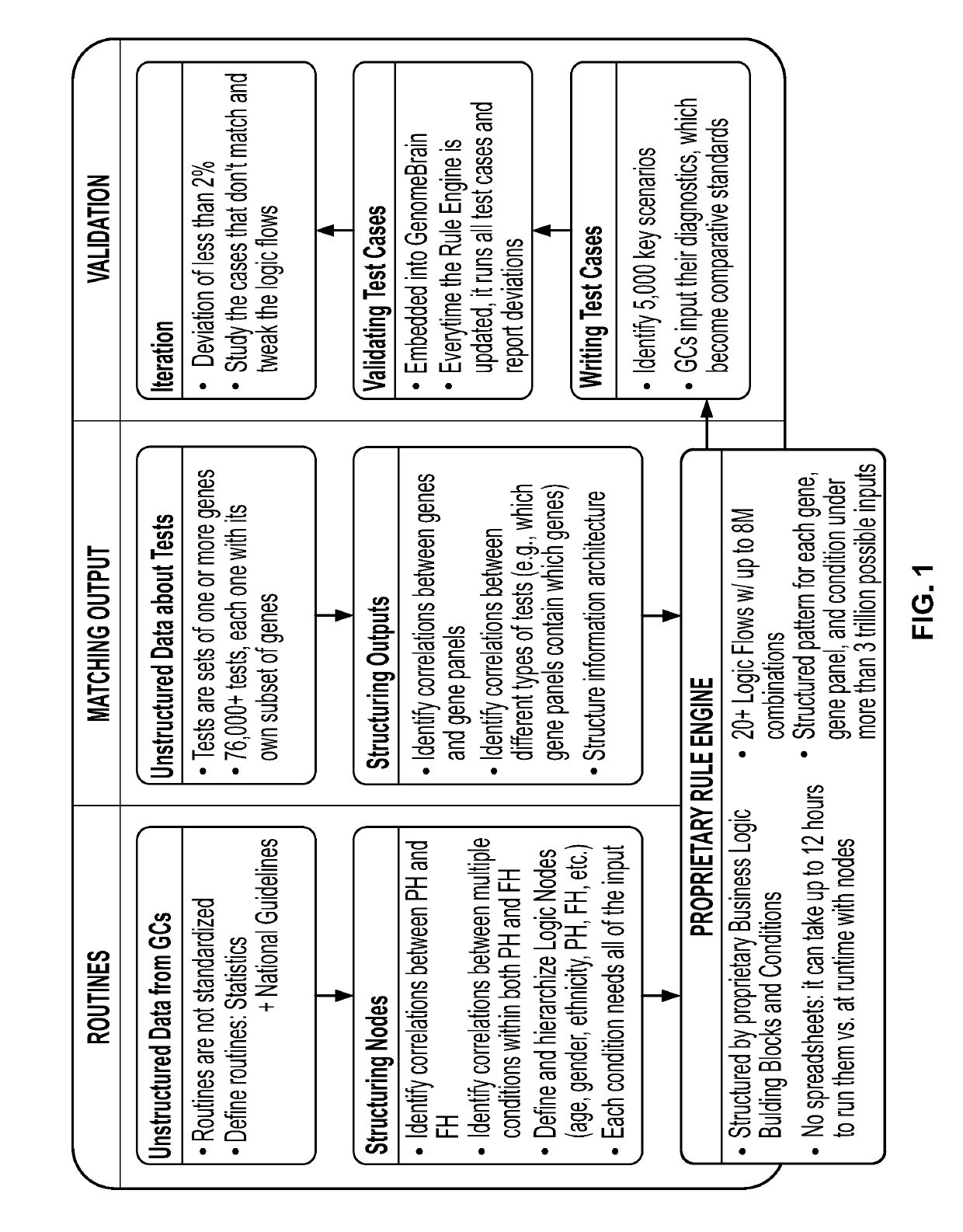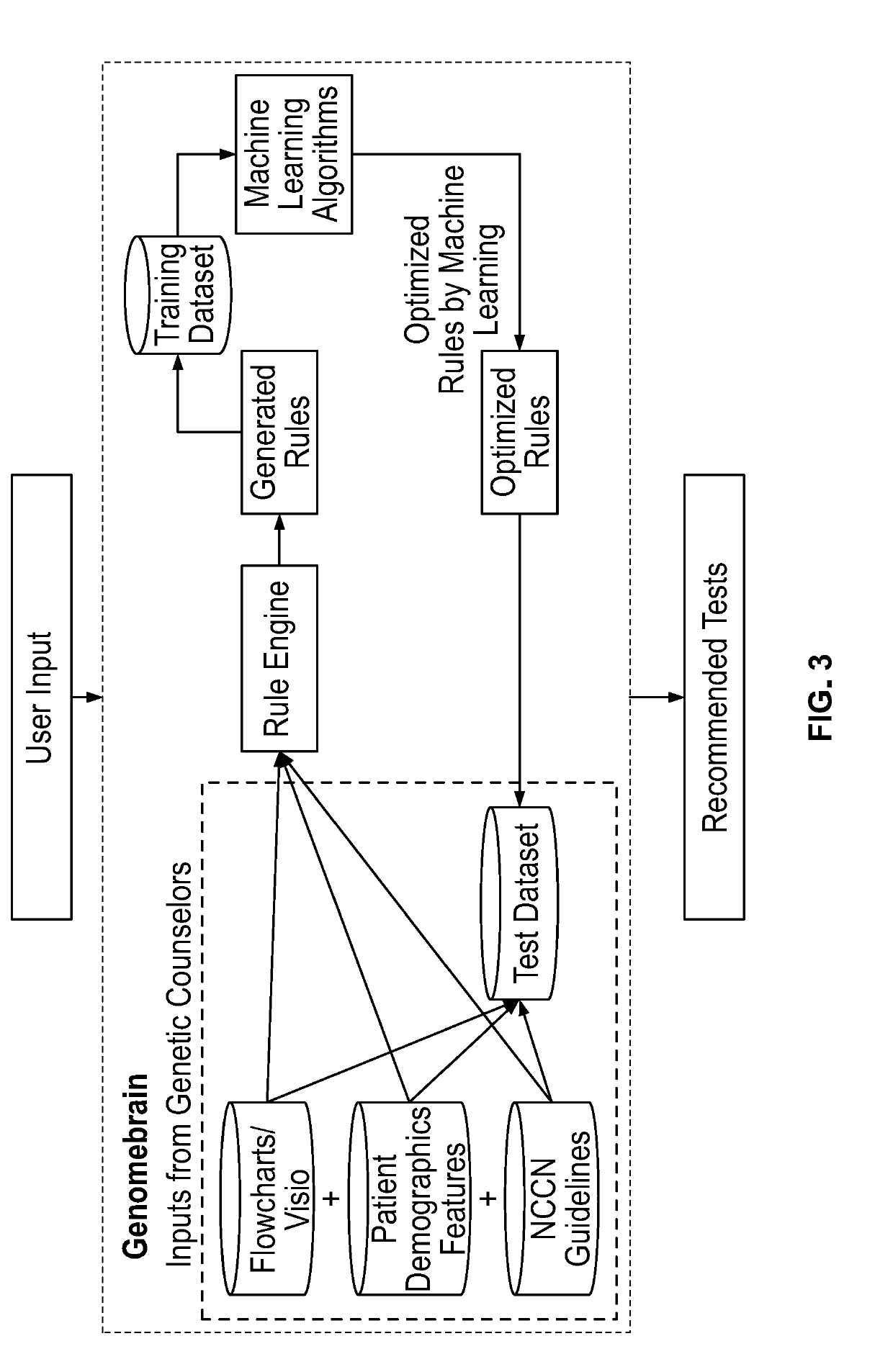Artificial intelligence and machine learning platform for identifying genetic and genomic tests
a technology of genetic and genomic tests and artificial intelligence, applied in the field of artificial intelligence and machine learning technology, can solve the problems of not being able to easily assess the risk of genetic disorders, not being able to get access to a genetic counselor, and not being able to come to the referral too late, so as to improve the identification of genetic tests
- Summary
- Abstract
- Description
- Claims
- Application Information
AI Technical Summary
Benefits of technology
Problems solved by technology
Method used
Image
Examples
example implementations
Section III: Example Implementations
EXAMPLE 1
Use of Genetic Test Matching Platform: Hereditary Cancer
[0107]An example use of one implementation of the Al / ML platform will now be described with respect to identifying appropriate genetic tests relating to Hereditary cancer. To receive customized results for individuals and patients, the following data can be captured by the platform, e.g., by a potential test subject inputting the information into an electronic portal:
[0108]Example of Hereditary Cancer Assessment: The questions are dynamic (i.e., the following questions can change based on the answers to the prior questions). Additionally, the questions can be closed-ended with multiple choices.
[0109]Start by Asking Demographic Questions:
[0110]Age, Sex(biological), Ethnicity—Ashkenazi Jew, South Asian, Hispanic, Black / African American, South East Asian / Pacific Islander, White / Caucasian, Other. (For this example, the user selects Male, 64 years old, and Black and Hispanic ethnicity).
[0...
example 1
rocess
[0131]The details of the personal and family cancer history drive a set of actions on the back end of the platform. In this case, by the user's choosing prostate cancer in their personal history, the rules engine identifies the set of questions to be asked based on the answers and suggests the relevant genetic tests. FIG. 9 depicts a flowchart representing a procedural question-asking flow relating to prostate cancer that is followed by the rules engine.
[0132]On the front end, the user moves through the assessment and reaches the family history section. If there is a history of only one cancer in the family, the rules engine is used to determine the next set of questions. In cases where there are two or more cancers in the family, a separate set of qualifying questions is asked to ascertain if the cancers truly are. On the back end, the system leverages a two-cancer combination rules engine, as shown in FIG. 10, which helps determine the right genetic testing recommendations. ...
example 2
Backend Process
[0155]The details of the user's pregnancy history (natural conception vs. assisted reproductive technologies) and family history of genetic disorders drive a unique set of actions on the back end of the platform. There is a different flow for male users and female users. Further, the questions change based on whether the user / partner is pregnant or not. If the user is pregnant but has used an assisted reproductive technology, then the flow is further different from users who may be pregnant by natural conception.
[0156]In this case, by choosing that she is pregnant and used IVF, the rules engine identifies the set of questions to be asked and, based on the answers, suggests the relevant genetic tests.
[0157]FIG. 11 depicts a flowchart of one implementation of a process flow used by the platform rules engine for questioning a female user regarding reproductive genetics. Based on the inputs provided by the user in this example and this process flow, the following tests ar...
PUM
 Login to View More
Login to View More Abstract
Description
Claims
Application Information
 Login to View More
Login to View More - R&D
- Intellectual Property
- Life Sciences
- Materials
- Tech Scout
- Unparalleled Data Quality
- Higher Quality Content
- 60% Fewer Hallucinations
Browse by: Latest US Patents, China's latest patents, Technical Efficacy Thesaurus, Application Domain, Technology Topic, Popular Technical Reports.
© 2025 PatSnap. All rights reserved.Legal|Privacy policy|Modern Slavery Act Transparency Statement|Sitemap|About US| Contact US: help@patsnap.com



